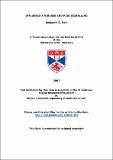Files in this item
Influenza A viruses and PI3K signalling
Item metadata
| dc.contributor.advisor | Randall, R. E. | |
| dc.contributor.author | Hale, Benjamin G. | |
| dc.coverage.spatial | 243 | en |
| dc.date.accessioned | 2008-05-15T10:37:30Z | |
| dc.date.available | 2008-05-15T10:37:30Z | |
| dc.date.issued | 2007-09-28 | |
| dc.identifier | uk.bl.ethos.552074 | |
| dc.identifier.uri | https://hdl.handle.net/10023/483 | |
| dc.description.abstract | The influenza A virus non-structural (NS1) protein is multifunctional, and during virus-infection NS1 interacts with several factors in order to manipulate host-cell processes. This study reports that NS1 binds directly to p85β, a regulatory subunit of phosphoinositide 3-kinase (PI3K), but not to the related p85α. Expression of NS1 was sufficient to activate PI3K and cause the phosphorylation of a downstream mediator of PI3K signalling, Akt. However, in virus-infected MDCK cells, the kinetics of Akt phosphorylation did not correlate with NS1 expression, and suggested that negative regulation of this signalling pathway occurs subsequent to ~8h post-infection. Mapping studies showed that the NS1:p85β interaction is primarily mediated by the NS1 C-terminal domain and the p85β inter-SH2 (Src homology 2) domain. Additionally, the highly conserved tyrosine at residue 89 (Y89) of NS1 was found to be important for binding and activating PI3K in a phosphorylation-independent manner. The inter-SH2 domain of p85β is a coiled-coil structure that acts as a scaffold for the p110 catalytic subunit of PI3K. As NS1 does not displace p110 from the inter-SH2 domain, a model is proposed whereby NS1 forms an active heterotrimeric complex with PI3K, and disrupts the ability of p85β to control p110 function. Biological studies revealed that a mutant influenza A virus (Udorn/72) expressing NS1 with phenylalanine substituted for tyrosine-89 (Y89F) exhibited a small-plaque phenotype, and grew more slowly in MDCK cells than wild-type virus. Unexpectedly, another mutant influenza A virus strain (WSN/33) expressing NS1-Y89F was not attenuated in MDCK cells, yet appeared to be less pathogenic than wild-type in vivo. Overall, these data indicate a role for NS1-mediated PI3K activation in efficient influenza A virus replication. The potential application of this work to the design of novel anti-influenza drugs and vaccine production is discussed. | en |
| dc.format.extent | 2675 bytes | |
| dc.format.mimetype | application/pdf | |
| dc.language.iso | en | en |
| dc.publisher | University of St Andrews | |
| dc.subject | Influenza | en |
| dc.subject | Virus | en |
| dc.subject | PI3K | en |
| dc.subject | Akt | en |
| dc.subject | Vaccine | en |
| dc.subject | Anti-virals | en |
| dc.subject.lcc | QR470.H2 | |
| dc.subject.lcsh | Influenza A virus | en |
| dc.subject.lcsh | Cellular signal transduction | en |
| dc.subject.lcsh | Phosphoinositides | en |
| dc.subject.lcsh | Viruses--Reproduction | en |
| dc.title | Influenza A viruses and PI3K signalling | en |
| dc.type | Thesis | en |
| dc.type.qualificationlevel | Doctoral | en |
| dc.type.qualificationname | PhD Doctor of Philosophy | en |
| dc.publisher.institution | The University of St Andrews | en |
This item appears in the following Collection(s)
Items in the St Andrews Research Repository are protected by copyright, with all rights reserved, unless otherwise indicated.

